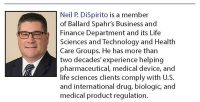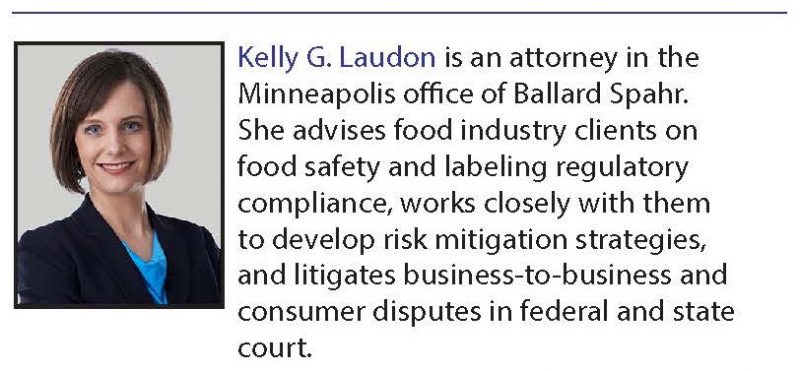![What’s New at FDA (1) [Converted]](https://www.fdli.org/wp-content/uploads/2018/04/Whats-New-at-FDA-1-Converted-800x450.jpg)
What’s New at FDA for Medical Products and Foods?
by Neil P. DiSpirito and Kelly G. Laudon
In an agency where it takes as many as 550 days to hire, change is coming rapidly, not only in streamlining hiring practices, but in rapid approval programs for medical devices and generic drugs. Regulation by the U.S. Food and Drug Administration (FDA or the agency) has taken a collaborative and educational approach where streamlining and efficiency are the modern mantras of the new mandates. Policy changes and new guidance documents are being issued quickly, as the ideas that have dwelled restlessly in the thoughts of Center Directors are being launched into tangible actions. Transparency has become the new norm.
Medical Products
Policy Roadmap 2018
The agency’s 2018 Policy Roadmap promises advances in the regulation of gene and cell-based therapies that hold the promise to treat a wider range of debilitating disorders and deliver cures to currently incurable diseases. Expedited approvals of mobile apps and monitoring offer clinicians real time remote diagnoses and patients faster treatment. Faster review and regulation of more targeted medicines will allow patients to realize the benefits of new drug and biologic treatments in a timely manner. New approval methods and guidance documents for medical devices offer timelier restored mobility for patients to lead lives less hindered from the impact of chronic ailments.
Legislative Enhancements
Legislative enhancements, including the 21st Century Cures Act and the recently enacted FDA Reauthorization Act of 2017, expand FDA’s ability to capitalize on new opportunities including using real world data and funding agency modernization. Enhancements such as clarifying the least burdensome ways to show drug and device safety, consideration of patient experience data and the impact of disease and treatment on patients’ quality of life all must be factored into a risk/benefit analysis. For example, the 21st Century Cures Act establishes a priority review program for breakthrough devices, modernizes medical device clinical trial requirements and clarifies the regulation of medical software. In addition, the Act calls for regulatory exclusivity incentives to be provided for developers of new antibiotic classes and for the inclusion of unrepresented communities in clinical trials. Measurement of biomarkers, a streamlined review process, the easing of regulation on Class I and II devices, and the creation of a comprehensive patient access policy all provide strategic focus in reaching the goal of expediting patient access.
Complex Generic Drug Development
Under the new Drug Competition Action Plan FDA is advancing new policies to bring more competition to the drug market, especially in complex generic drug development. FDA intends to expedite the review of Abbreviated New Drug Applications (ANDAs) where there are fewer than three ANDAs approved for the reference listed drug and publish a list of all off-patent pharmaceuticals with limited or no competition.
FDA has drafted two new guidance documents, “Formal Meetings Between FDA and ANDA Applicants of Complex Products Under GDUFA Guidance for Industry” and “ANDAs for Certain Highly Purified Synthetic Peptide Drug Products That Refer to Listed Drugs of rDNA Origin,” to facilitate efficiency in using the pathways for complex generic drug approvals. These documents provide a road map for complex generic drug developers where none existed previously.
The Digital Innovation Action Plan
Last year nine companies were selected to participate in FDA’s precertification digital health program. The program, if it proves successful, will allow companies with an embedded culture of quality and expertise to bring digital products to market faster with more self-governance and less agency oversight. The program is scalable with the goal of allowing a large number of qualifying companies to participate. The precertification process would provide the agency with assurance that the developers produce high quality, safe, and effective products, allowing less information to be submitted to the agency than is currently required.
The Shift in Quality, Inspections, and Enforcement
In late January 2018, FDA issued a direct final rule to end biennial inspections of biologic producers that are also registered as drug or device establishments. The new rule ignites a move by FDA to eliminate duplicative and outdated rules. In FDA’s current view, the biennial inspection schedule was replaced by the Food and Drug Administration and Safety and Innovation Act’s risk-based inspection schedule. Importantly, in the agency’s view, the inspection requirements of Section 704 of the Federal Food, Drug, and Cosmetic Act (FDCA) incorporate all of the requirements in Section 600.22.
FDA is also initiating a pilot program for medical device manufacturers. The pilot program will evaluate manufacturers’ processes using objective metrics, optimization of their resources, and their culture of quality.
Yet despite the whirlwind changes, FDA remains committed to safe and efficacious products and a pristine food supply. FDA’s initiatives to provide guidance, education, and collaboration are markedly positive steps forward. As practitioners, it provides an opportunity for us and our clients to have meaningful dialogue with the agency long before client mistakes form the basis of an enforcement action.
Food
FSMA Implementation, Education, and Soft Enforcement
FDA has now finalized seven rules under the Food Safety Modernization Act (FSMA), some of which already require compliance and others of which will require compliance over the next few years. All companies must now be in compliance with the Preventive Controls for Human Food Rule and the Preventive Controls for Animal Food Rule. The first round of compliance deadlines passed in 2017 for the Produce Safety, Foreign Supplier Verification Program (FSVP), and Sanitary Transportation Rules; additional deadlines for smaller companies’ compliance with those rules will pass in the first half of 2018, and beyond. There are no compliance dates for the Rule on Accreditation of Third-Party Certification Bodies, because participation in the program is voluntary.
FDA is taking a three-step approach to FSMA implementation. The first phase was to set the rules, which is now completed. The second phase is to design strategies by which FDA will promote and oversee industry compliance. FDA is currently in this phase, focusing its attention on education and outreach, and it is taking a relatively soft approach to enforcement as both companies and regulators gain familiarity with the requirements. During this second phase of implementation, FDA intends to take enforcement action under the new regulations when it identifies a violation that poses a threat to public health, but its enforcement efforts with respect to other violations will focus more on education and the encouragement of voluntary compliance. FDA will increase its enforcement efforts in the third phase of implementation, but has pledged to continue to monitor, evaluate, and refresh its FSMA practices as needed.
FDA has focused in recent months on educating industry on how to comply with the FSMA regulations and on engaging in outreach efforts to increase knowledge and compliance. In January 2018, FDA launched a redesigned FSMA website to help stakeholders more easily access information and resources. It has developed additional tools to assist companies in FSMA compliance. Examples of new tools include a color-coded calendar that visually identifies the compliance deadlines for various FSMA regulations, a food safety training video for carriers subject to the Sanitary Transportation Rule, and software tools to help owners and operators of food facilities create food safety and food defense plans specific to their facilities.
FDA demonstrated its commitment to put education above enforcement action when it announced in September 2017 that it would delay routine inspections under the Produce Safety Rule until Spring 2019, long past the January 2018 compliance deadline for large farms. FDA has been reaching out to farmers and training both farmers and regulators on the requirements of the rule and best practices for compliance, and wanted additional time to engage in education, outreach, and training. It is also taking a “soft” approach to enforcement of the FSVP rule, providing companies advanced notice of inspections and informing companies of violations they have observed rather than issuing warning letters.
FDA has issued a number of guidance documents over the past several months to help importers and food producers meet their FSMA obligations, and to train regulators on what they should look for when inspecting companies for compliance. The agency is in the process of developing comprehensive guidance on the Preventative Controls for Human Food Rule. It recently released draft guidance on the FSVP rule and on the meaning of various terms under the FSVP and Produce Safety regulations and has issued Small Entity Compliance Guides on the FSVP and Sanitary Transportation Rules.
FDA continues to engage with stakeholders in hearing feedback on the new regulations and draft guidance and has issued enforcement discretion to withhold taking enforcement action on certain regulations. FDA issued enforcement discretion guidance regarding (1) the application of FSVP to certain importers of raw agricultural commodities, (2) the requirement for importers to obtain written assurances from customers, and (3) supply chain verification requirements for co-manufacturers.
In January 2018, FDA announced the first accreditation body under its voluntary Accredited Third-Party Certification Program, accrediting ANSI-ASQ National Accreditation Board (ANAB), an organization jointly owned by the American National Standards Institute (ANSI) and the American Society for Quality (ASQ), for a 5-year term. It also launched the Voluntary Qualified Importer Program (VQIP), a voluntary fee-based program which offers expedited review and entry of human and animal food into the United States.
Menu Labeling Guidance
FSMA is not the only regulatory scheme for which FDA has been educating and issuing draft guidance. In November 2017, FDA released supplemental guidance for industry on menu labeling. The supplemental guidance addresses comments the agency received on the interim final rule that extended the compliance date for menu labeling from May 5, 2017, to May 7, 2018, and provides various graphics to illustrate the agency’s interpretations of the menu labeling provisions and practical ways for industry to comply with these provisions.
New GRAS Guidance
In November 2017, FDA issued draft guidance on best practices to follow when convening a panel of experts to evaluate whether a substance is “generally recognized as safe” (GRAS) under the conditions of its intended use. A substance that is GRAS does not require premarket review and approval by FDA as a food additive. To be GRAS, a substance’s safe use in food must be widely recognized by qualified experts based on publicly available scientific information or be subject to a GRAS regulation. FDA’s new draft guidance provides specifics on best practices for convening a GRAS panel.
Compliance Deadline for the New Nutrition Facts Panel Pushed Back to 2020
In September 2017, FDA proposed an extension of the compliance dates for use of the new Nutrition Facts Panel from July 26, 2018, to Jan. 1, 2020, for manufacturers with $10 million or more in annual food sales, and a similar extension to Jan. 1, 2021 for smaller companies. Pending completion of the rulemaking to extend the deadline, FDA will exercise enforcement discretion and not enforce the July 26, 2018 and July 26, 2019 compliance dates.
Conclusion
Scott Gottlieb, the new FDA commissioner, appears to be conquering an arduous task. Gottlieb, along with some center directors, continues to modernize the agency while working to ensure the public health and reward industry innovation. Taking a collaborative, education-based approach to the implementation and enforcement of regulations, Gottlieb and his management team have seemingly drawn support from critics and supporters alike.
Smaller companies with limited staff and new companies with limited expertise should benefit the most. Access to decision-making agency personnel under these new policies should become easier with new policies issued on granting meeting requests. Companies working to advance gene and cell-based therapies that hold the promise to treat a wider range of debilitating disorders and deliver cures to currently incurable diseases generally fit into this category. Complex generic drug producers will now by guidance be granted formal meetings with FDA to discuss the science and regulation required of these producers, leading to efficient use of existing pathways.
Implementing new legislative enhancements such as clarifying the least burdensome ways to show drug and device safety, exclusivity incentives provided for developers of new antibiotic classes, the measurement of biomarkers, streamlined review processes, and the easing of regulation on Class I and II devices should all serve to better incentivize innovation and expedite patient access.
FDA’s precertification digital health program and pilot manufacturing programs broaden the agency’s approach to innovation and modernization and evaluate manufacturers’ processes implementing metric measurement, thus optimizing both industry and agency resources.
Similarly, with respect to food safety and labeling, the agency has been focused on education as the most effective way to bring companies into compliance with new regulatory requirements. This is particularly true with respect to those industry sectors that were not previously regulated by FDA, such as produce growers and transportation companies. FDA’s education-based approach to initial enforcement of FSMA regulations will be particularly helpful to new and smaller companies, some of whom learn for the first time about the new regulations when FDA comes knocking for an initial inspection. A more collaborative approach is consistent with the way FDA has worked to enact regulations over the past several years, and under Commissioner Gottlieb, this relatively industry-friendly approach continues.
What remains to be seen is the impact these changes will have on unsettled issues before the agency. For example, addressing the extent to which drug, biologic, and device makers can market their products for off-label uses. Or the extent to which compliance and enforcement policies can be lessened and still be effective. At what point will FDA begin to demand more with respect to compliance? The agency has stated that the time period for its education-based approach to FSMA compliance will have its limits, but that until it has educated various industries and issued sufficient guidance to enable compliance, it will continue to be less stringent in its enforcement approach, as both companies and regulators are still learning what is required. The test will be safety over time and some adjustments will undoubtedly have to be made. But these changes should endure throughout 2018 and for the foreseeable future.
Update Magazine
March/April 2018









